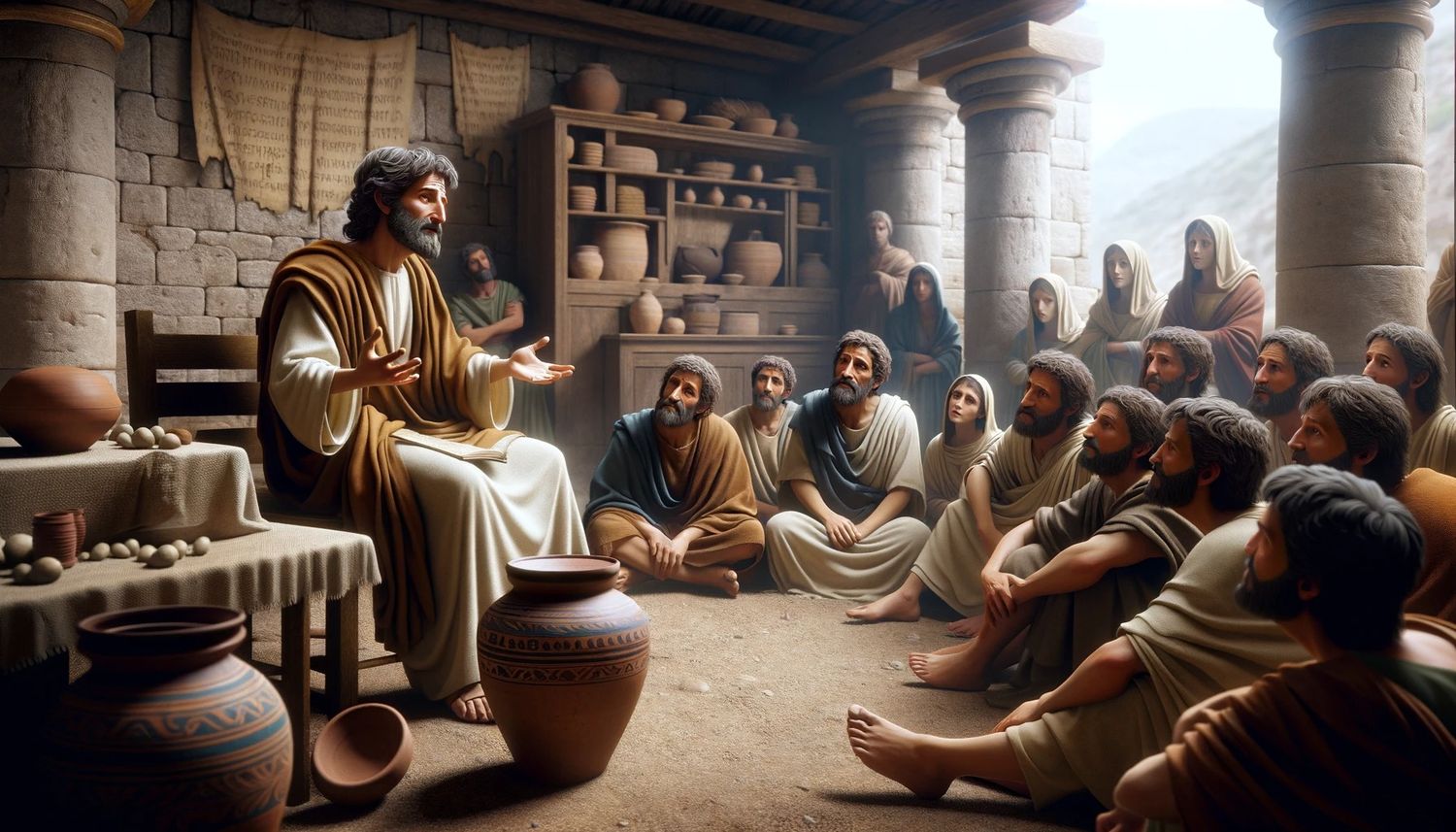Home>Theology and Spirituality>How Does Baptism Cleanse Original And Personal Sin In Adults?


Theology and Spirituality
How Does Baptism Cleanse Original And Personal Sin In Adults?
Published: February 29, 2024
Jason DeRose, Managing Editor at Christian.net, uses his expertise in religion and journalism to deepen understanding of faith's societal impacts. His editorial leadership, coupled with a strong academic background, enriches the platform’s diverse content, earning him recognition in both journalism and religious circles.
Discover how baptism cleanses original and personal sin in adults through the theology and spirituality of this sacred sacrament. Explore its transformative power today.
(Many of the links in this article redirect to a specific reviewed product. Your purchase of these products through affiliate links helps to generate commission for Christian.net, at no extra cost. Learn more)
Table of Contents
Understanding the Concept of Original Sin
Original sin is a fundamental doctrine in Christianity, particularly in the Catholic Church, that refers to the state of sin in which all humans are born as a result of the disobedience of Adam and Eve in the Garden of Eden. According to the biblical narrative in the book of Genesis, Adam and Eve, the first human beings, disobeyed God by eating the forbidden fruit from the tree of knowledge of good and evil. As a consequence of their disobedience, sin entered the world, and all of their descendants inherited this sinful nature. This concept of original sin is deeply ingrained in Christian theology and has significant implications for the understanding of human nature and the need for redemption.
-
Inherited Sinful Nature: The concept of original sin teaches that as descendants of Adam and Eve, all human beings inherit a sinful nature. This means that from the moment of conception, individuals are born with a tendency towards sin and are separated from God.
-
Universal Condition: Original sin is considered a universal condition that affects every human being, regardless of their personal actions or choices. It is not a sin that individuals commit themselves, but rather a state of being that they are born into.
-
Need for Redemption: The doctrine of original sin underscores the need for redemption and salvation. It highlights the belief that humans cannot save themselves from this inherent sinfulness and require divine intervention to be reconciled with God.
-
Theological Debates: Throughout history, the concept of original sin has been the subject of theological debates and interpretations within Christianity. Different denominations have varying perspectives on the extent of the impact of original sin and how it is transmitted through generations.
Understanding the concept of original sin provides the foundational basis for the role of baptism in addressing this inherited state of sin and the subsequent personal sins committed by individuals.
Read more: How Did Baptism Originate
The Role of Baptism in Cleansing Original Sin
-
Sacramental Cleansing: Baptism is viewed as the sacrament through which the original sin inherited from Adam and Eve is cleansed. In the Catholic tradition, the act of baptism is believed to wash away the stain of original sin, thereby restoring the individual to a state of grace and initiating them into the community of believers.
-
Rebirth and Renewal: The ritual of baptism symbolizes a spiritual rebirth, signifying the washing away of the sinful nature inherited from the first human beings. Through the pouring of water or immersion in water, the individual is symbolically cleansed and reborn into a new life, free from the burden of original sin.
-
Necessity for Salvation: According to Catholic teaching, baptism is considered necessary for salvation, particularly in the case of infants who have not reached the age of reason. It is believed that without the grace imparted through baptism, individuals remain in a state of separation from God due to the presence of original sin.
-
Entry into the Church: Baptism is also seen as the sacramental rite through which individuals are formally incorporated into the body of Christ, which is the Church. It marks the beginning of the individual's journey as a member of the Christian community and signifies their acceptance into the faith.
-
Cleansing of Sinful Nature: The cleansing of original sin through baptism is seen as the first step in the process of spiritual purification and growth. By removing the barrier of original sin, individuals are able to begin their spiritual journey with a renewed relationship with God and a restored state of grace.
-
Continued Spiritual Development: While baptism is believed to cleanse the individual of original sin, it is also understood as the initiation into a life of ongoing spiritual growth and transformation. It marks the beginning of a lifelong journey of faith, during which the individual strives to live in accordance with the teachings of Christ and the Church.
-
Symbolic Act of Grace: Baptism is not merely a symbolic ritual but is believed to be an act through which God imparts grace to the individual. This grace is understood to be transformative, enabling the baptized person to live a life that is pleasing to God and to resist the temptations of sin.
Understanding the role of baptism in cleansing original sin provides insight into the significance of this sacrament in the life of a Christian and its connection to the broader theological understanding of sin and redemption.
Addressing Personal Sin through Baptism in Adults
Baptism in adults not only addresses the concept of original sin but also serves as a means of cleansing personal sins that individuals may have committed prior to their decision to embrace the Christian faith. When adults choose to undergo baptism, it signifies their repentance for past transgressions and their desire for spiritual renewal. The act of baptism is seen as a transformative experience, symbolizing the washing away of personal sins and the individual's commitment to living a life in accordance with the teachings of Christ. Here are some key aspects of how baptism addresses personal sin in adults:
-
Repentance and Forgiveness: Adult baptism is often preceded by a period of reflection, repentance, and confession of sins. This process allows individuals to acknowledge their personal sins, seek forgiveness from God, and express their genuine desire to turn away from sinful behaviors. Baptism then becomes a visible expression of this inner transformation, signifying the forgiveness of past sins and the beginning of a new life in Christ.
-
Renewal of the Spirit: Through the act of baptism, adults experience a spiritual renewal that transcends the symbolic washing with water. It represents a profound inner change, where the individual is spiritually reborn and empowered to live a life that is aligned with the teachings of Jesus. This renewal is accompanied by a sense of liberation from the burden of past sins and a newfound commitment to living a life of righteousness.
-
Embracing Grace and Mercy: Baptism in adults underscores the belief in God's grace and mercy. It is an affirmation of the understanding that no matter the extent of one's personal sins, God's love and forgiveness are available to those who genuinely seek reconciliation. The act of baptism becomes a tangible expression of embracing God's grace and entrusting one's life to His transformative power.
-
Commitment to Holiness: Adult baptism signifies a conscious decision to pursue holiness and moral uprightness. By publicly declaring their faith and undergoing baptism, individuals commit themselves to a life of discipleship, seeking to live in a manner that reflects the values and virtues espoused in the Christian faith. This commitment involves a continuous effort to resist temptation, grow in spiritual maturity, and strive for moral integrity.
-
Integration into the Christian Community: Through baptism, adults are welcomed into the community of believers, where they receive support, guidance, and encouragement in their journey of faith. This sense of belonging to a spiritual family provides a nurturing environment for individuals to address their personal sins, receive pastoral care, and participate in the communal life of the Church.
In summary, adult baptism serves as a transformative and redemptive experience, addressing not only the concept of original sin but also the personal sins of individuals who choose to embrace the Christian faith. It symbolizes repentance, forgiveness, renewal, and a commitment to living a life that is reflective of the teachings of Jesus Christ.
The Symbolism and Ritual of Baptism in the Catholic Church
The symbolism and ritual of baptism in the Catholic Church are deeply rooted in the rich tradition and theology of the faith. Baptism is not merely a symbolic act but is considered a sacrament, a visible sign of God's grace and the spiritual reality it imparts to the individual. The ritual of baptism incorporates various symbolic elements that convey profound spiritual truths and carry significant meaning within the Catholic tradition.
-
Water: Central to the ritual of baptism is the use of water, which holds multifaceted symbolism. Water is a universal symbol of cleansing and purification, signifying the washing away of sin and the initiation of a new life. In the sacrament of baptism, the pouring of water or immersion in water represents the spiritual cleansing and rebirth experienced by the individual. It symbolizes the removal of the stain of original sin and the restoration to a state of grace.
-
Anointing with Oil: Another significant element of the baptismal ritual is the anointing with sacred oil, known as chrism. This anointing symbolizes the sealing of the baptized person with the gift of the Holy Spirit and their incorporation into the priestly, prophetic, and kingly mission of Christ. It signifies the empowerment and consecration of the individual for their role as a member of the Christian community.
-
White Garment: Following the baptismal rite, the newly baptized person is often clothed in a white garment. This white garment serves as a symbol of the person's new life in Christ, reflecting purity, innocence, and the state of grace. It signifies the spiritual transformation and the putting on of the new self, free from the burden of sin.
-
Candle: The presentation of a lit candle to the newly baptized individual or their parents represents the light of Christ entering their life. The candle symbolizes the presence of Christ as the light of the world and serves as a reminder of the baptized person's call to live as a child of the light, dispelling the darkness of sin and ignorance.
-
Community Participation: Baptism in the Catholic Church is not merely a private affair but is celebrated within the context of the faith community. The presence of the assembly of believers, including sponsors, family members, and the wider Church community, underscores the communal nature of the sacrament. It signifies the support, welcome, and responsibility of the community in nurturing the faith of the newly baptized individual.
-
Trinitarian Formula: The baptismal ritual includes the invocation of the Trinitarian formula, wherein the individual is baptized "in the name of the Father, and of the Son, and of the Holy Spirit." This formula reflects the central Christian belief in the Triune God and the individual's incorporation into the life of the Trinity through the sacrament of baptism.
The symbolism and ritual of baptism in the Catholic Church are rich in meaning and significance, conveying the profound spiritual truths of initiation, cleansing, empowerment, and incorporation into the body of Christ. The sacrament of baptism serves as a visible sign of God's saving grace and the beginning of a lifelong journey of faith and discipleship within the Catholic tradition.
The Spiritual Transformation and Renewal in Adult Baptism
The sacrament of baptism holds profound significance in the spiritual transformation and renewal experienced by adults who choose to undergo this sacred rite within the Catholic Church. Adult baptism represents a pivotal moment in the individual's spiritual journey, marking a profound inner change and a reorientation of their life in accordance with the teachings of Jesus Christ. The following aspects illuminate the depth of spiritual transformation and renewal in adult baptism:
-
Personal Decision and Commitment: Adult baptism is a conscious and voluntary decision made by individuals who have reached an age of understanding and discernment. It signifies a personal commitment to embrace the Christian faith, seek forgiveness for past transgressions, and embark on a new life guided by the principles of love, compassion, and moral integrity.
-
Renunciation of Sin and Evil: Prior to adult baptism, candidates undergo a period of preparation that includes the renunciation of sin and the affirmation of their faith in God. This process involves a sincere examination of conscience, acknowledging personal failings, and expressing a genuine desire to turn away from sinful behaviors. The act of renunciation signifies a decisive break from the influence of evil and a wholehearted turning towards God.
-
Reception of Grace and Spiritual Rebirth: Through the sacrament of baptism, adults receive the grace of God, which is understood to be transformative and life-giving. The pouring of water or immersion in water symbolizes the cleansing of sin and the spiritual rebirth of the individual. This reception of grace brings about a profound inner renewal, enabling the baptized person to experience a restored relationship with God and a sense of spiritual wholeness.
-
Empowerment for Christian Living: Adult baptism empowers individuals to live out their faith in practical ways. It signifies the endowment of the Holy Spirit, who strengthens and guides the baptized person in their journey of discipleship. This empowerment enables them to bear witness to the Gospel, resist temptation, and actively participate in the mission of the Church to bring about justice, compassion, and reconciliation in the world.
-
Integration into the Christian Community: Through adult baptism, individuals are welcomed into the community of believers, where they find support, encouragement, and fellowship. This integration into the Christian community provides a nurturing environment for spiritual growth, where the newly baptized are mentored, guided, and embraced as valuable members of the Church.
-
Lifelong Journey of Faith: Adult baptism marks the beginning of a lifelong journey of faith, characterized by ongoing spiritual growth, learning, and transformation. It signifies a commitment to continually deepen one's relationship with God, engage in prayer and worship, and strive for moral and ethical living in accordance with the teachings of Jesus Christ.
-
Witness to God's Transformative Love: The spiritual transformation and renewal experienced in adult baptism serve as a powerful witness to the transformative love and mercy of God. It becomes a testimony to the redemptive power of God's grace, demonstrating that no one is beyond the reach of divine forgiveness and renewal.
In summary, adult baptism in the Catholic Church represents a profound spiritual transformation and renewal, signifying a conscious decision to embrace the Christian faith, seek forgiveness, and embark on a life of discipleship. It embodies the reception of grace, the empowerment for Christian living, and the integration into the faith community, marking the beginning of a lifelong journey of faith and spiritual growth.















